Job growth in Nebraska picked up in the first half of 2018 as employment expanded across most major industries. Service-providing firms continued to be primary drivers of job growth, but employment in the manufacturing sector also rebounded significantly. In addition to broad-based gains in employment across industries, employment data based on occupation shows particularly strong growth in certain kinds of jobs, including health-care practitioners, business and financial specialists and personal-service providers. In other occupations, wage gains have been more notable than employment gains as labor shortages for certain types of jobs have intensified.
Developments in Employment by Industry
Employment growth in Nebraska has accelerated in recent months. In the initial years following the 2007-09 recession, job growth in Nebraska generally matched or exceeded the national rate (Chart 1). Since 2014, state-level job growth has lagged that of the nation. In July 2018, however, employment in Nebraska expanded 1.7 percent from a year earlier, the fastest rate of growth since March 2012 and nearly matched the national rate of 1.8 percent.
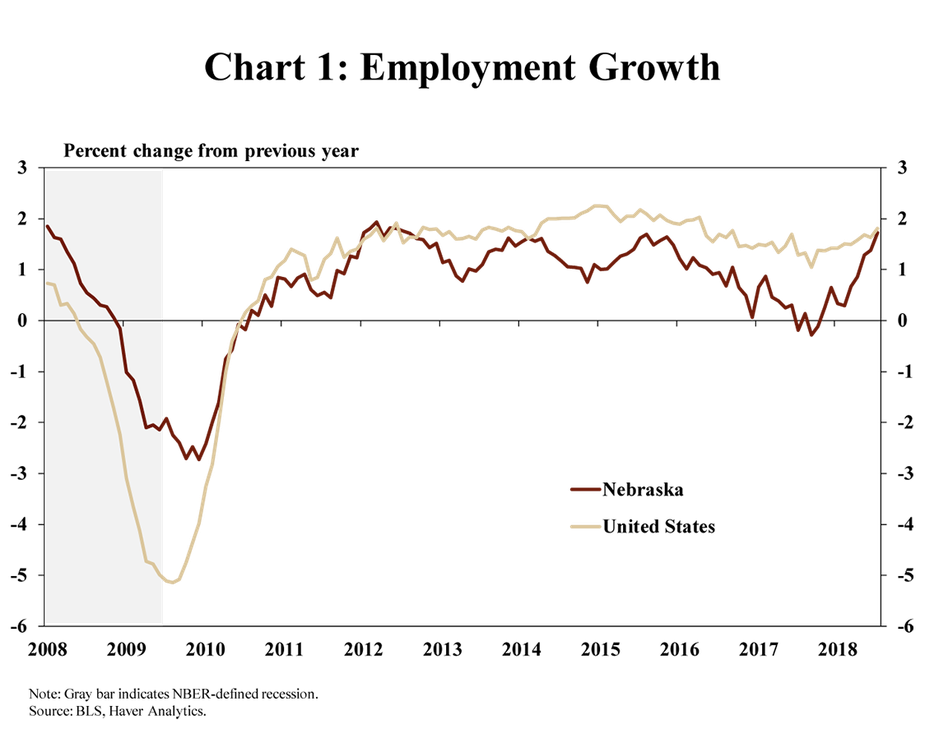
Industries that account for a large share of employment in Nebraska have been the primary drivers of recent job growth acceleration. Employment at manufacturing firms in July surged 4.5 percent, the strongest growth in the industry since August 1995 (Chart 2). In addition, job growth expanded more than 2 percent in other industries that account for a large number of jobs, such as professional and business services firms, leisure and hospitality firms and education and health service providers. The only industry where employment did not increase was in the information industry, which while it dropped sharply, accounts for just a small share of overall jobs in the state and includes firms involved in telecommunications and publishing.
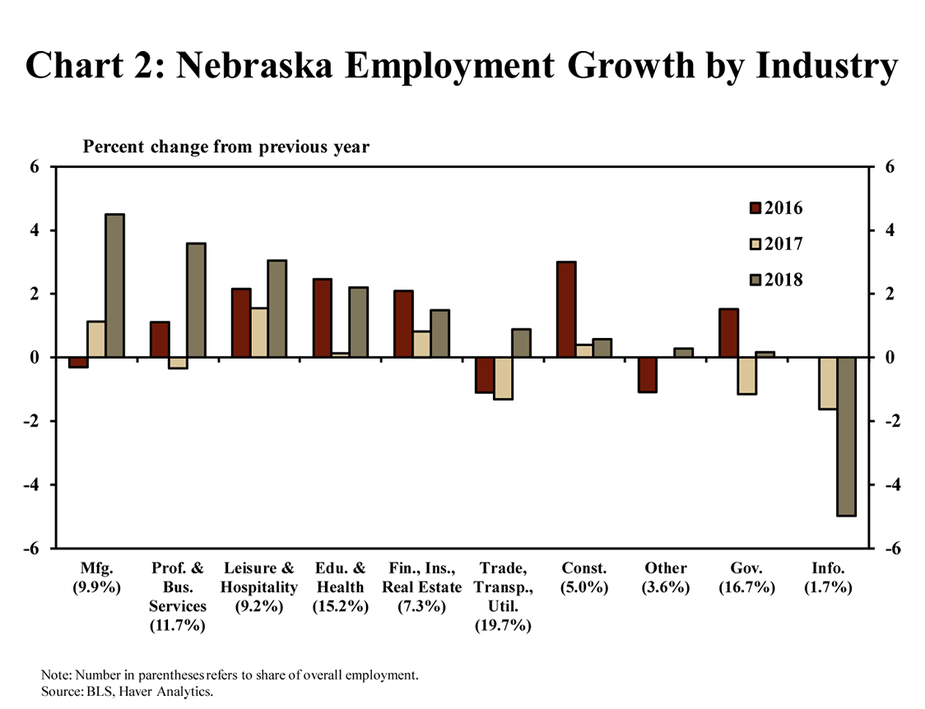
Within Nebraska’s major industries, job gains also were spread across various types of firms. In the manufacturing sector, employment growth expanded more than 4 percent at firms producing both durable goods and nondurable goods (Chart 3). Job growth among firms providing accommodation and food services also exceeded 4 percent in July. Even more notably, employment gains at firms providing support services—such as hiring and search firms, document preparation and clerical services firms, cleaning services firms and waste disposal services firms—exceeded 8 percent in July when compared with the previous year.
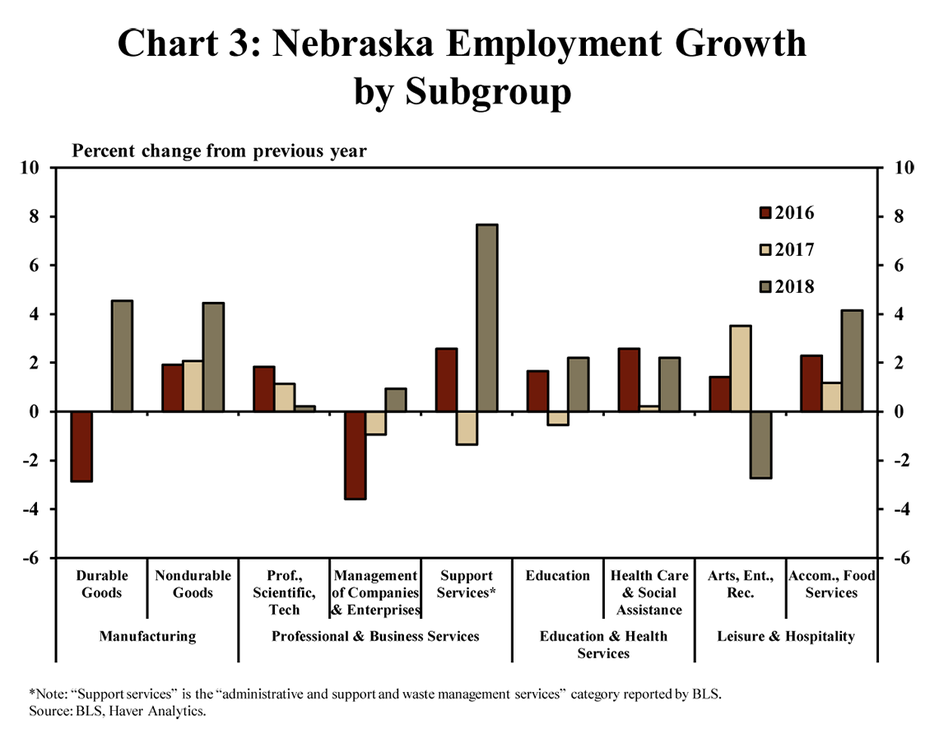
The recent surge in employment among goods-producing firms in Nebraska has been notable within the context of the current economic expansion. In July, employment at manufacturers of durable goods rebounded to its 2014 mark, the highest since the recession in 2009 (Chart 4). Manufacturers of nondurable goods (primarily food products) also continued to add jobs at a faster pace, reaching the highest point in nearly two decades. Jobs in the construction sector also have continued to increase and in recent months have exceeded their pre-recession peak.
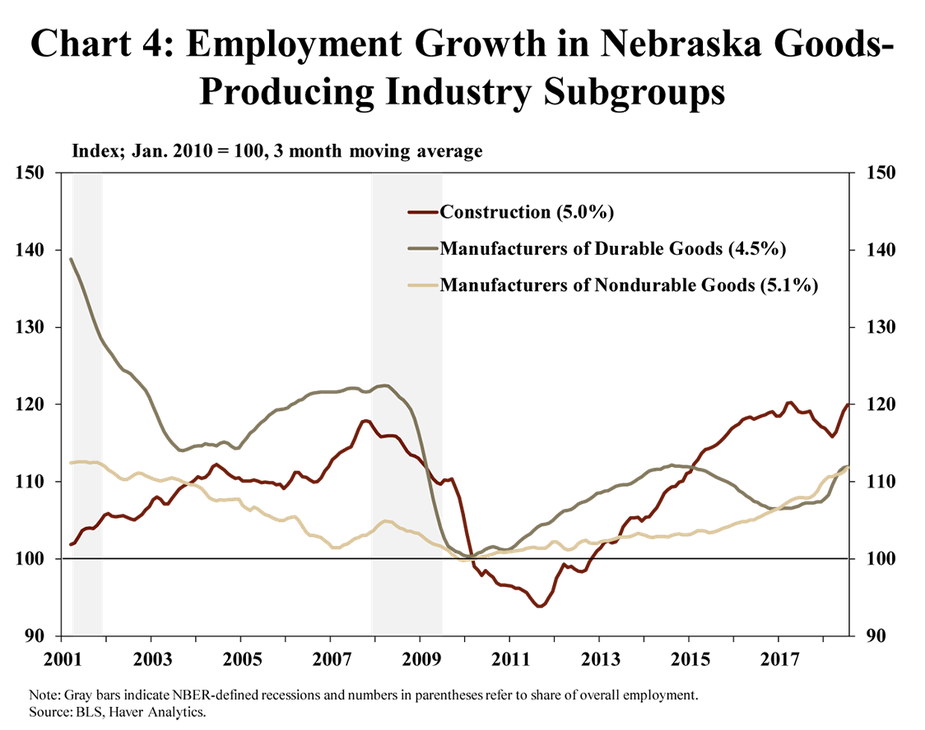
Similarly, employment at most types of service-providing firms has increased since 2010 and has advanced well beyond its pre-recession mark. Two of the fastest-growing industries, accounting for more than 20 percent of employment in Nebraska, have been firms providing health care or social assistance and firms providing food and accommodation services, such as restaurants and hotels (Chart 5). Even during the recession, employment at these firms declined very little, and in recent months has continued to trend steadily upward.
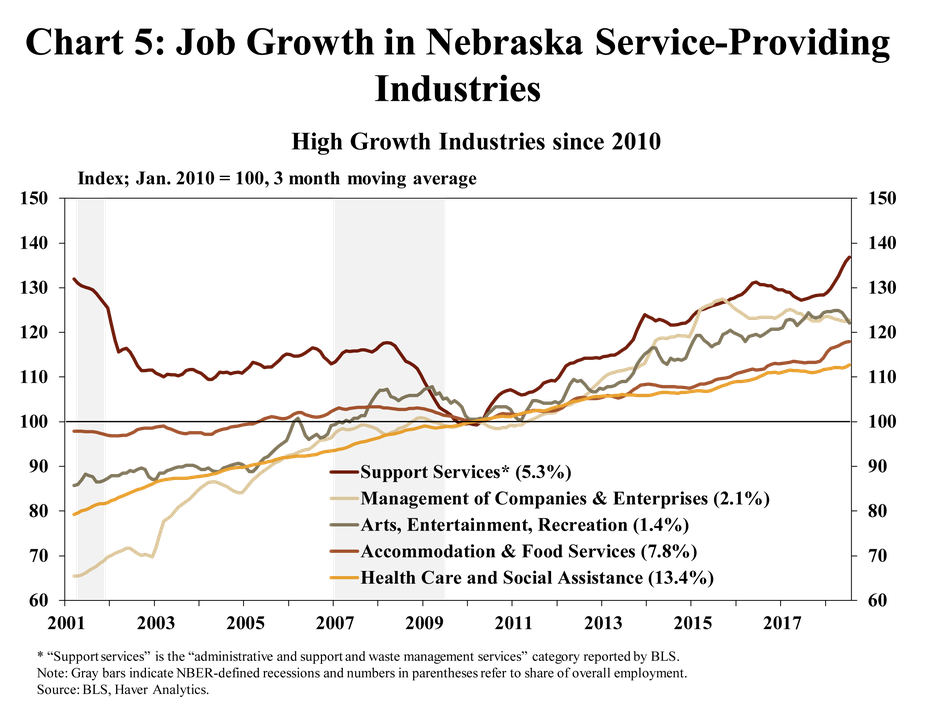
Other service-providing firms have continued to add jobs at a steady, but more moderate, pace. Employment at retail-based firms, which account for more than 10 percent of jobs in Nebraska, has recovered gradually since 2010 after declining in the last recession (Chart 6). Firms providing financial and insurance-based services, also a notable and growing industry in the state, have continued to add jobs at a faster pace.
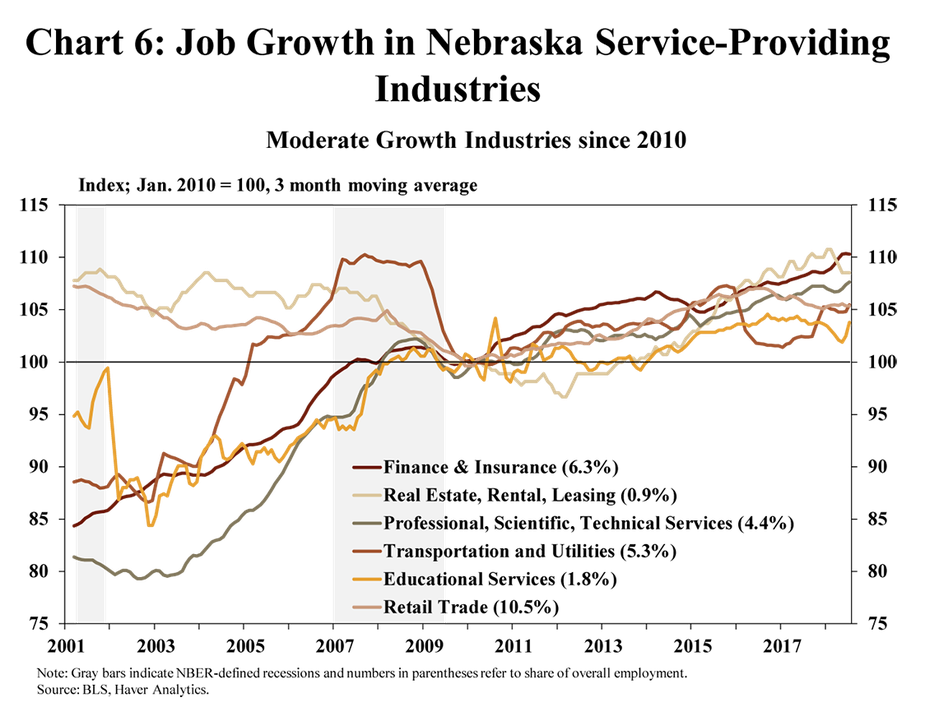
Despite steady employment growth among most service-providing firms, growth has been more sluggish in a few specific industries. Most notably, employment in the government sector has increased very little since 2010 (Chart 7). Federal, state and local government employment has increased only 2-3 percent during that time. Firms providing wholesale services, which include product sales to other firms from warehouse facilities, have shed jobs since 2014, in addition to a long-term decline in firms providing information services.
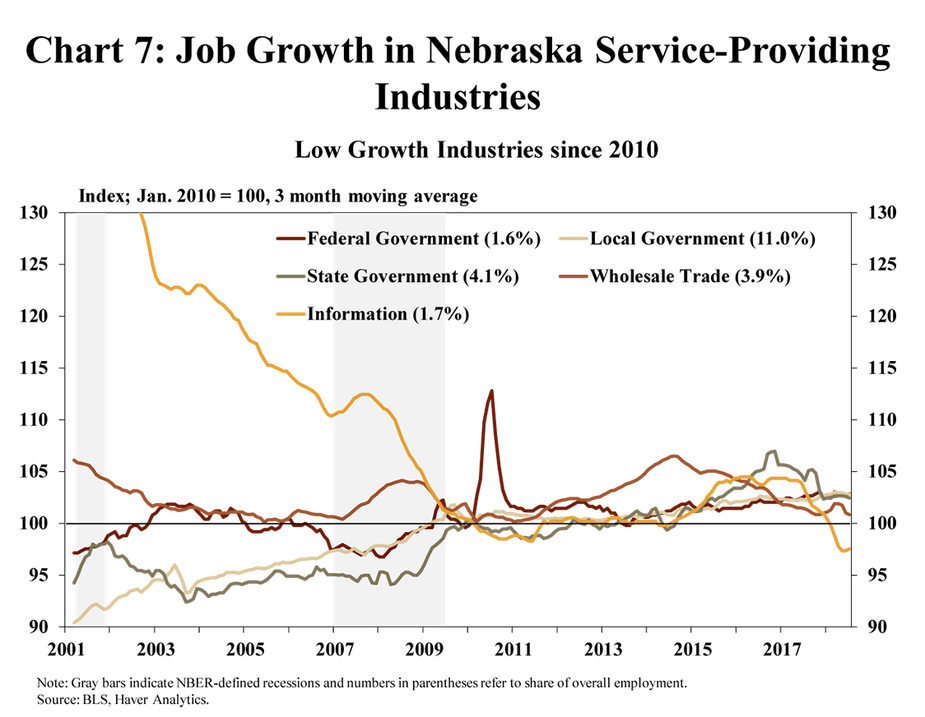
Developments in Employment by Occupation
Employment growth has increased among most industries in Nebraska in recent months, but the types of jobs that have been added at these firms have differed notably. Similar to the nation, as Nebraska’s economy has evolved over the years, so have the types of jobs in highest demand. Wage growth has also differed widely by the type of occupation. For the discussion that follows, Table 1 summarizes the main categories of occupations in Nebraska and examples of occupations within each category.
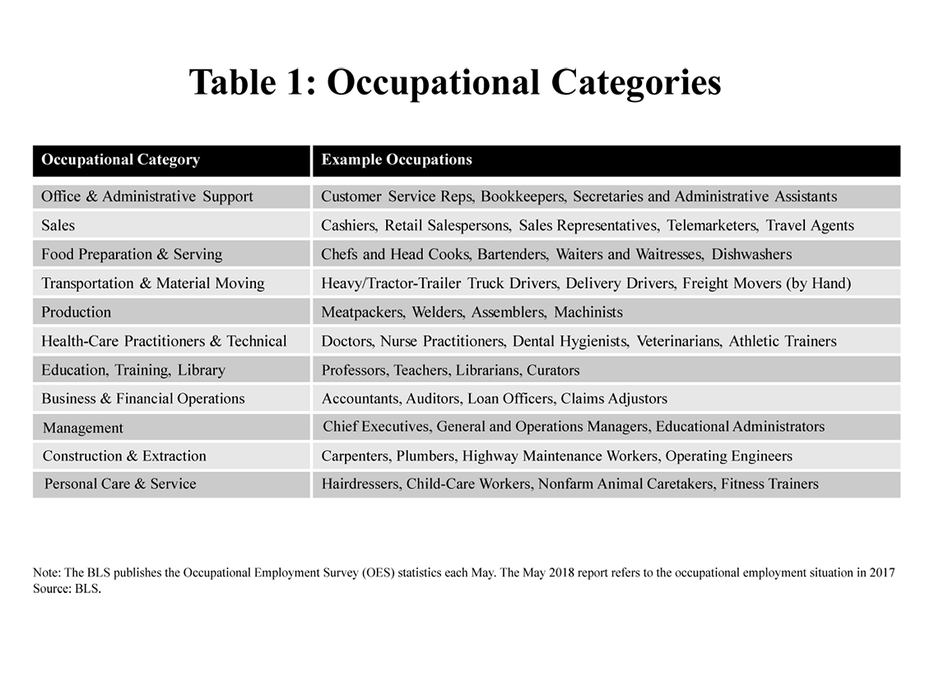
An assessment of state-level occupation data shows that job growth for individuals employed in some occupations has significantly exceeded that of other occupations. Since 2010, the average pace of hiring has been strongest for individuals employed as providers of personal care and related services (Chart 8). In fact, the number of individuals employed in that occupation has increased more than 10 percent annually, on average, in the current decade. The employment of business or financial professionals and health care practitioners also has increased significantly as firms providing those services have grown in recent years in Nebraska’s metropolitan areas. In contrast, the employment of production workers and office support personnel has declined since 2010 as technology and automation have played an increasingly prominent role.

Since 2010, wage growth has increased for most occupations in Nebraska. In addition to the strongest gains in employment, personal care and service jobs also have exhibited the strongest gains in real wages, increasing more than 1.3 percent per year, on average. Wages for food service providers since 2010 also have increased on average more than 1 percent. The only major occupation in which wages have declined in real terms since 2010 has been management, where real wages have declined about 0.3 percent per year.
In addition to changes in the rate of job growth and wages based on occupation, the composition of Nebraska’s workforce also has shifted slightly over the years. Since 2001, employment of office and administrative support staff has declined most notably. In 2001, this occupation accounted for 19 percent of employment in the state, but by 2017 it had declined to 16 percent (Chart 9). The share of employment in the production occupation has also declined significantly. In contrast, more Nebraskans are employed today in food service, health care and in business and financial operations than in years past.
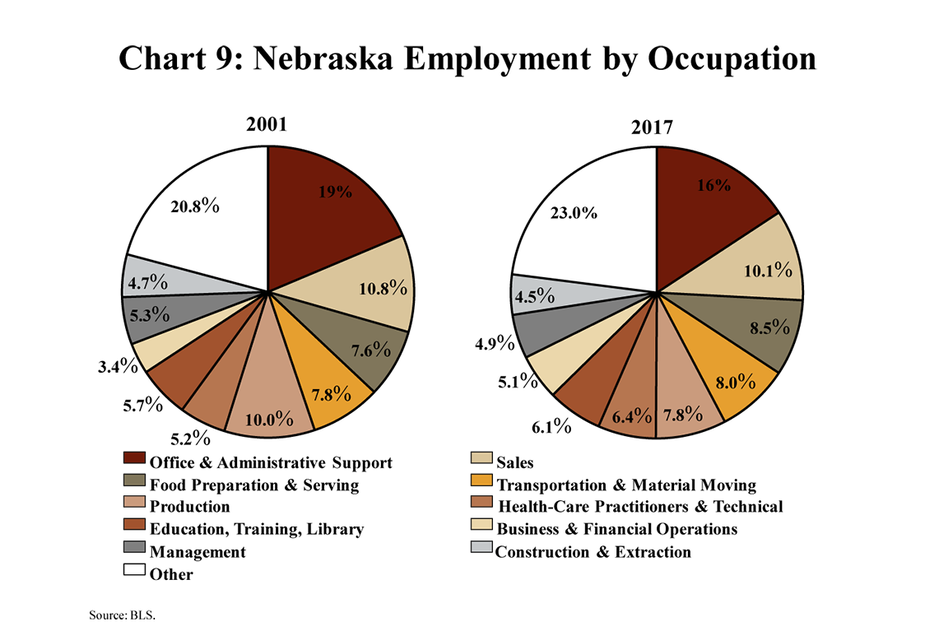
Although employment has increased for most occupations in Nebraska since the start of this century, the rates of growth by occupation have differed significantly from 2016 to 2017. The rate of employment growth in 2017 exceeded average growth in the previous 15 years among several large occupational categories (Chart 10). Recent gains in the employment of managers, health-care practitioners, educators and construction workers were greater than their longer-term growth rates. Conversely, the growth in employment of other large occupational categories in Nebraska between 2016 and 2017 was slower than longer-term average growth. Recent gains in employment in four categories—business and financial operations, personal care and service, transportation and material moving, and sales—all were more than 2 percentage points lower than the average rate of growth between 2001 and 2016. With the increase in employment in 2018, it is possible, however, that job growth for some of these occupations also has increased more recently.
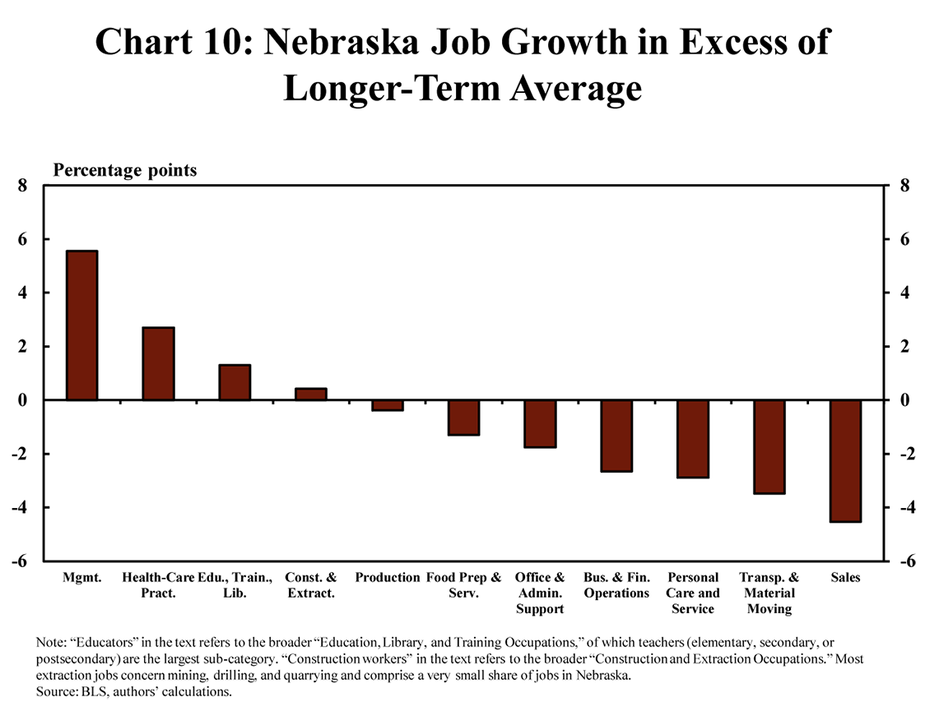
Despite lower employment growth in 2017 among some occupations, wages for most occupations increased at a slightly faster pace than in previous years. From 2016 to 2017, the most notable acceleration was in real wages for food preparers and servers (Chart 11). However, the occupations with the largest gains in employment relative to historical averages also experienced more limited wage gains, suggesting that the degree of labor market tightness among occupations has been a recent factor driving increases in job growth and wages. The growth in production workers, for example, was relatively small between 2016 and 2017, but intensifying labor shortages may have played a role in driving wages higher for that occupation. Anecdotal evidence suggests that this labor market tightness has continued in 2018, and that recent wage gains may be even larger than their historical average among transportation and construction workers.
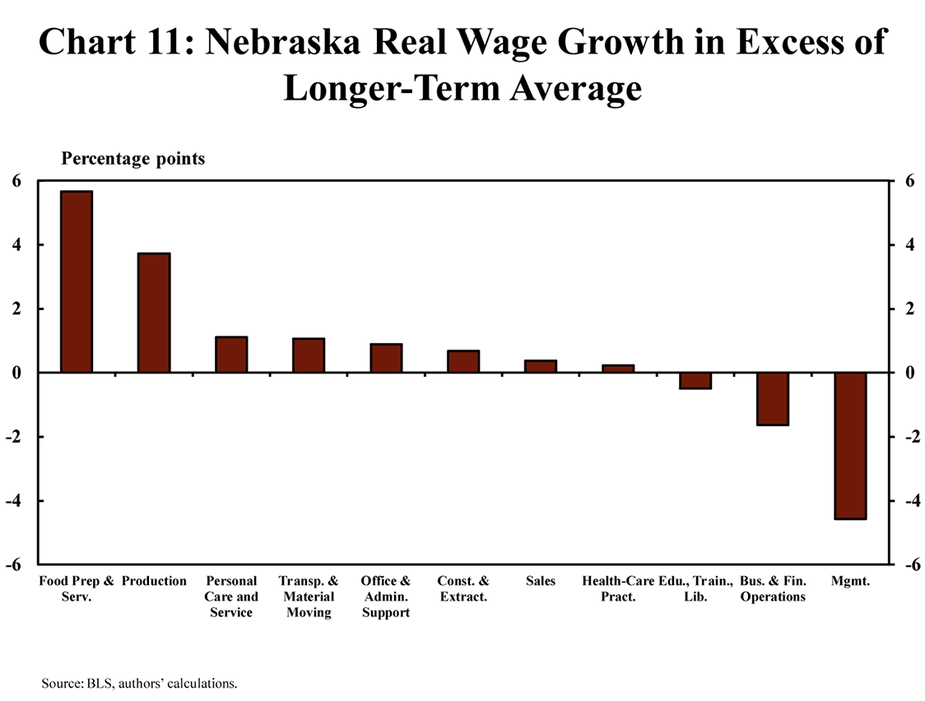
Conclusion
Nebraska’s labor markets continued to tighten in 2018 as job growth accelerated and unemployment remained historically low. Through the first half of the year, employment increased in most industries in the state and wages generally have continued to rise. As Nebraska’s economy continues to add more service-oriented positions, individuals employed in occupations connected to those services, such as health care, personal care and finance have seen demand for their skills rise most significantly in recent times.
The views expressed in this article are those of the authors and do not necessarily reflect the views of the Federal Reserve Bank of Kansas City or the Federal Reserve System.
